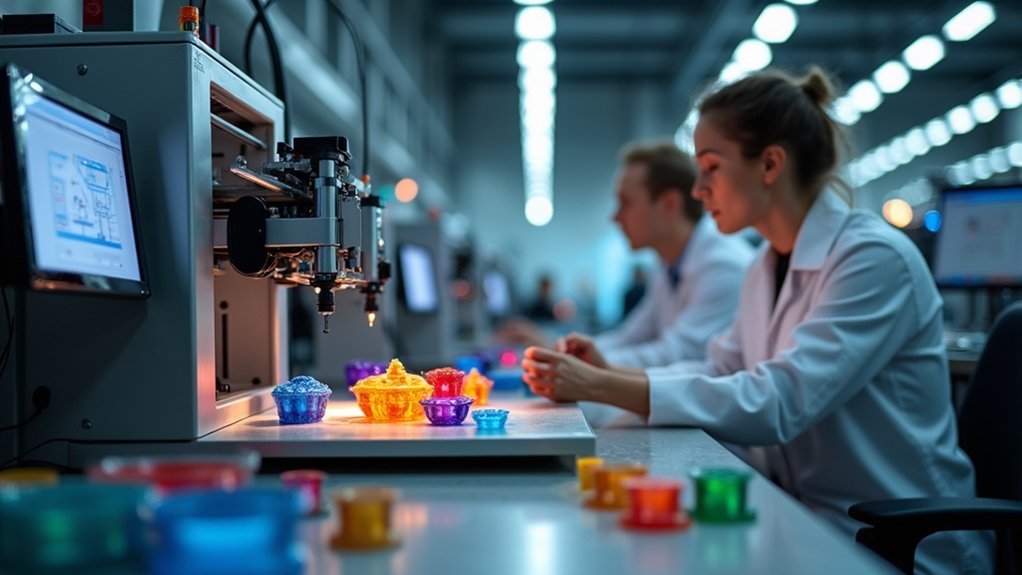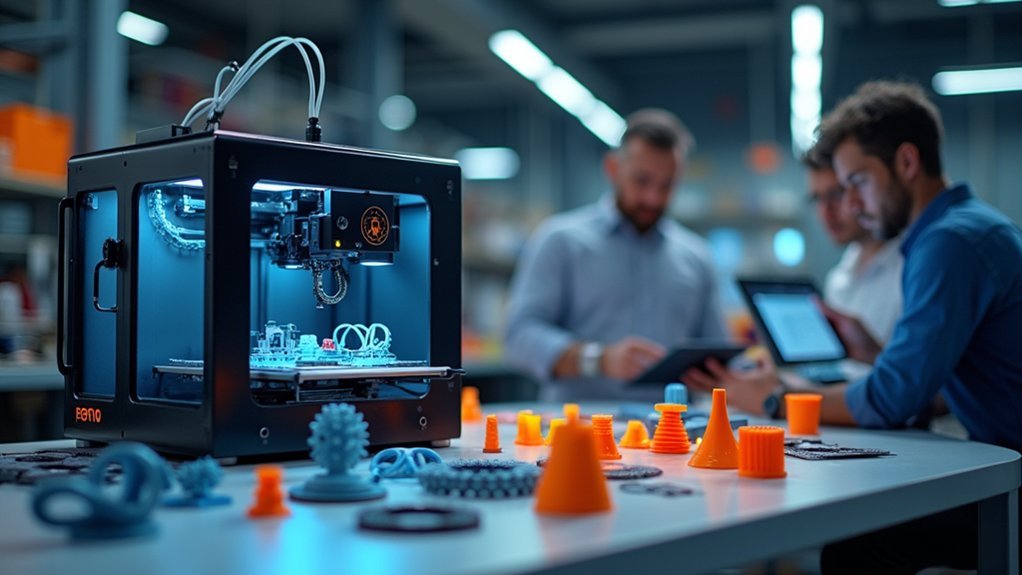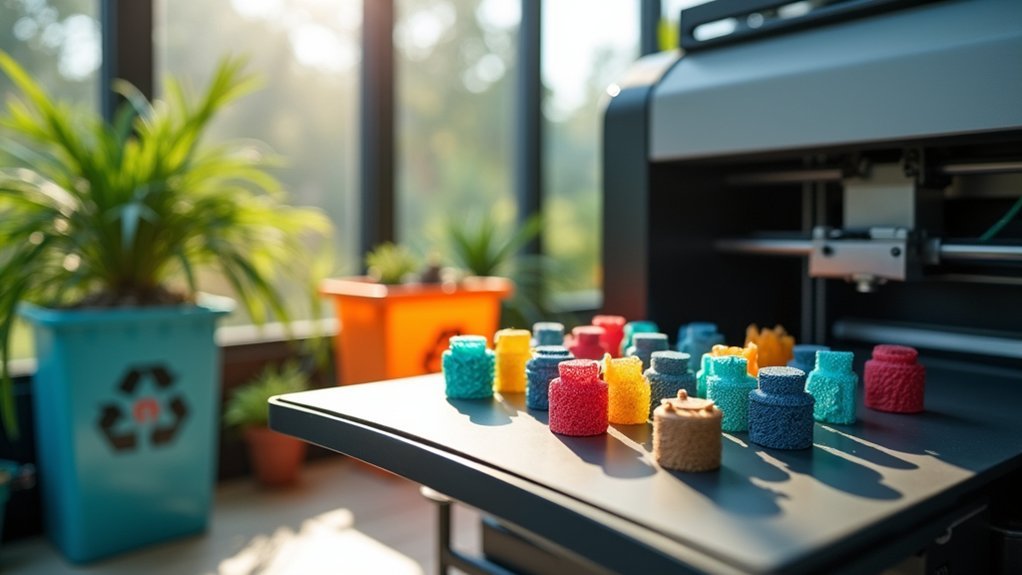You’ll revolutionize your manufacturing process with industrial resin printers that deliver microscopic precision, eliminate costly tooling, and reduce production costs by up to 75%. These systems achieve exceptional resolution with minimal waste while printing at speeds up to 24 centimeters per hour, cutting lead times by 40%. They’re perfect for automotive prototyping, medical devices, aerospace components, and custom electronics. You’ll also reduce energy consumption by 64% and material waste by nearly 50%, making your operations more sustainable and profitable than ever before.
Precision Manufacturing and Quality Enhancement

When you’re manufacturing precision components, industrial resin printers deliver exceptional resolution that transforms how you approach detailed production work.
You’ll achieve considerably thinner layers than filament-based methods, eliminating the stair-stepping effect that compromises surface quality. This superior detail reproduction lets you create intricate geometries and fine features essential for miniature parts and complex components.
You’ll maintain consistent precision across multiple production runs, achieving microscopic detail levels critical for aerospace, automotive, and microelectronics applications.
The layer-by-layer process guarantees tight tolerances necessary for structural integrity and precise fit requirements.
Precision layer control ensures manufacturing tolerances meet exacting specifications for critical component applications requiring structural reliability and exact dimensional conformity.
Your post-processing needs decrease dramatically since resin prints emerge with smooth finishes directly from the printer.
This reduction in manual interventions preserves dimensional accuracy while accelerating quality control, resulting in higher first-pass yields and reduced manufacturing waste. Industrial resin printers provide faster print times compared to traditional manufacturing methods, enabling you to meet demanding production schedules.
Economic Benefits and Cost Reduction
Beyond the technical advantages, industrial resin printers deliver substantial economic benefits that fundamentally reshape your manufacturing cost structure.
You’ll achieve up to 75% cost reduction compared to conventional manufacturing, as demonstrated in sand casting where costs dropped from €3,600 to €900 per unit. You’ll eliminate expensive tooling and molds since only CAD files are needed for complex designs.
Small batch and customized production become economically viable without traditional tooling overhead. You’ll reduce material waste through high precision manufacturing and minimize inventory costs with on-demand production.
Lead times decrease by approximately 40%, improving cash flow and competitive positioning. Additionally, you’ll mitigate supply chain risks and tariff costs through localized production while benefiting from reduced maintenance expenses and equipment downtime. Manufacturing complex geometries becomes possible as single pieces, eliminating traditional assembly requirements and associated labor costs.
Accelerated Production and Innovation

Industrial resin printers revolutionize your production timeline by achieving print speeds up to 24 vertical centimeters per hour—dramatically outpacing conventional SLA systems that typically manage only 20-36 millimeters per hour.
You’ll complete entire build volumes in under two hours, accelerating your design iteration cycles without sacrificing quality or detail.
This speed advantage transforms your innovation process. You can rapidly modify designs and produce physical prototypes, reducing time-to-market for new products.
The technology maintains dimensional accuracy and surface finish quality at these accelerated speeds, eliminating traditional speed-versus-quality tradeoffs. Advanced slicing software optimizes printer movements and reduces redundant actions to maximize efficiency.
You’ll benefit from enhanced scalability through large build volumes that accommodate multiple parts simultaneously.
This capability supports lean manufacturing principles, enabling just-in-time production strategies while meeting high-demand requirements in competitive manufacturing environments.
Industry-Specific Manufacturing Applications
Across diverse manufacturing sectors, you’ll find industrial resin printers delivering specialized solutions that traditional production methods struggle to match. Whether you’re developing automotive prototypes, creating custom medical devices, or producing aerospace components, resin printing adapts to your industry’s unique demands.
| Industry | Key Applications |
|---|---|
| Automotive | Rapid prototyping, tooling, end-use parts validation |
| Medical/Dental | Custom implants, surgical guides, patient-specific prosthetics |
| Aerospace/Defense | Lightweight components, complex geometries, on-demand spares |
| Electronics | Detailed prototypes, custom enclosures, ergonomic designs |
You’ll achieve faster iteration cycles in product development while maintaining the dimensional accuracy and surface quality your applications require. From biocompatible dental crowns to precision aerospace parts, industrial resin printers enable you to produce components that meet strict industry standards efficiently. The aerospace and defense sector has embraced this technology since 1989, now representing a significant 16.8% share of the global additive manufacturing market.
Sustainability and Resource Optimization

While industrial resin printers excel at meeting industry-specific production demands, they’re also transforming manufacturing’s environmental footprint through intelligent resource management.
You’ll achieve nearly 50% reduction in material waste since additive processes use only what’s needed, eliminating excess stock removal. Your energy consumption drops dramatically—up to 64% less than injection molding—while greenhouse gas emissions decrease by 38% through reduced machining and transportation needs.
Industrial resin printing delivers dramatic environmental gains: 50% less material waste, 64% lower energy use, and 38% reduced emissions.
You can leverage biodegradable resins from renewable sources that lower VOC emissions and require less production energy.
The design freedom lets you optimize geometries, reducing material use without compromising strength. You’ll minimize water consumption by avoiding traditional bonding processes, while distributed manufacturing capabilities reduce transport requirements through on-demand local production. This point-of-need fabrication approach eliminates the carbon-heavy logistics that typically account for the majority of manufacturing emissions.
Frequently Asked Questions
What Maintenance Requirements Do Industrial Resin Printers Have Compared to Other Manufacturing Equipment?
You’ll need more frequent cleaning and calibration than traditional manufacturing equipment. Resin printers require specialized maintenance for optical components, liquid resin handling, and consumable replacements that conventional machines don’t.
How Do You Ensure Worker Safety When Handling Industrial Resin Printing Materials?
You’ll need chemical-resistant gloves, safety goggles, and protective clothing when handling uncured resin. Ascertain proper ventilation with 5-10 air changes hourly, follow manufacturer instructions precisely, and train workers on emergency protocols.
What Training Is Needed for Operators to Use Industrial Resin Printers Effectively?
You’ll need formal education like an associate’s degree, specialized certification programs covering printer operation and safety protocols, plus hands-on training progressing from beginner to expert levels with material handling expertise.
How Do Industrial Resin Printers Integrate With Existing Manufacturing Workflow Systems?
You’ll integrate industrial resin printers through ERP and MES connections, enabling automated workflows from design to inspection. AI optimizes parameters while real-time monitoring guarantees seamless production alignment with existing factory systems.
What Are the Initial Setup Costs for Implementing Industrial Resin Printing Technology?
You’ll need $2,000-$15,000 for printers, plus post-processing equipment, workspace ventilation, resin materials ($100-$200/liter), safety gear, and training costs. Budget additional funds for software licenses and contingency expenses during implementation.





Leave a Reply